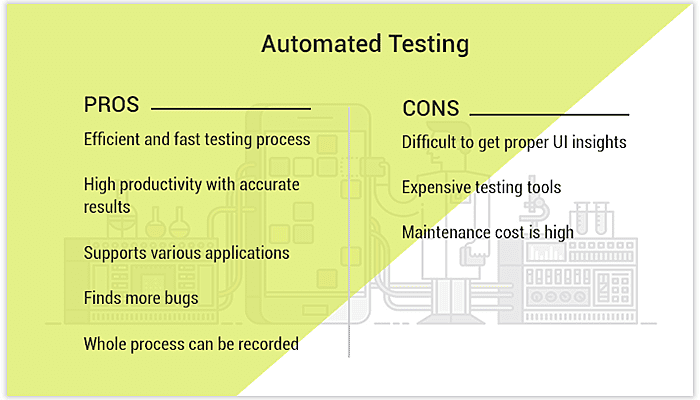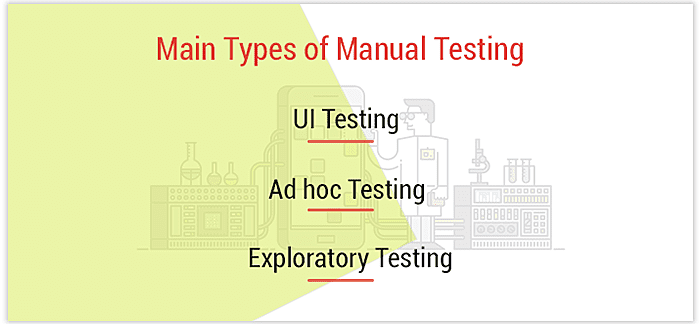
With today's mobile technology, people have successfully transformed their lives around the concept of digitalization. Mobile and web applications have now become an integral part of our day-to-day activities. It doesn't matter which sector we talk about, as now the majority of industry verticals have already adopted the application revolution along with mobile technology.
That's the reason why it is crucial that we highly focus on providing advanced features with excellent functionality to the end-users. And one of the main aspects that are required to make this happen is Mobile App Testing.
Testing itself has a ton of benefits to it, like improving the speed of the app and eliminating the bug issues from app functionalities. That's why mobile app testing is a necessary part of the app development process that can not be skipped.
The two key mobile app strategies are manual testing and automated testing; this is the part where most of the people get confused.
- Which mobile app testing strategy is better?
- Should I pick automated or manual testing for my application?
- What are the advantages and disadvantages of both of these strategies?
These are some of the many questions that several users, as well as the app developers, have regarding the manual and automated testing techniques. So, in this article, we will be stating the key differences between the automated testing and manual testing along with their pros and cons, to provide you a better understanding regarding it.
What is Automated Testing?
The automated mobile app testing is a known vital element of the TDD which stands for the Test Driven Development. Basically, automated testing relies on the pre-scripted tests that run automatically. The function of these pre-scripted tests is to compare the expected results and the actual results that are received.
With this comparison, we can easily determine if the mobile app is performing as per our expectation or not. In the automated type of testing, the tasks that are being repeated are executed, and then regression checks are performed to look at the state of the app after implementing some new changes.

Types of Automated Testing
These are the different types of testing that fall under the category of automated testing:
1. Regression Testing
The regression testing is more than just retesting; it is an entire process of testing if the old programming still works with the new changes applied by the app developers. So, when a newer version of an app is released, the previous test cases are run against this version to see if the older capabilities are still working or not.
2. Functional Testing
As the name suggests, in the functional testing every function of the mobile app is checked and verified in regards to the listed requirements. The functional testing is done by providing input and verifying the output while comparing the actual results with the expected one.
3. Unit Testing
The unit testing is a type of testing where the particular components and units of the application are tested. The main motive of unit testing is the validation of all components separately. A unit is the smallest part of an app that can be tested by providing one or more input and receive a single output from it.
4. GUI Testing
GUI testing stands for Graphic User Interface testing where we test the application's graphical user interface. This type of testing, including run tests on the screen's components including menus, icons, buttons, toolbar, dialog boxes, and many more.

Advantages of Automated Testing
- In automated testing, most of the procedure is automatic, which makes it into an efficient and fast testing process.
- The level of productivity is increased with the process and is quick to provide accurate testing results.
- A majority of applications supports the automated testing strategy.
- With automated testing, you can find more bugs in comparison to manual testing.
- The user can record the process of automated testing, which further allows it to be reused and executed.
Disadvantages of Automated Testing
- As there is no human element in automated testing, it becomes difficult to get appropriate insight into the visual aspects, including the fonts, colors, and other user interface elements.
- The advanced tools required for automation testing can be quite expensive.
- There are limitations with every automated testing tool like the test maintenance cost being high.

Need for Automated Testing
Here are some of the situations where we need automated testing:
- For eliminating human error: Because the automated tests are backed up by powerful scripts and tools, the chances of missing an issue or a bug are very low. That's why automated testing is referred to as more time effective as well as reliable.
- For advanced GUI testing: The automated testing can record the process while detecting for differences on various platforms that means it also supports the advanced GUI testing to find the regressions issues and errors.
- For handling repetitive tasks: The automated testing is great for handling the repetitive tasks and saves time, this comes in handy when the user is adding the same features or executing the same operations again and again.
What is Manual Testing?
The manual mobile app testing is the most known testing strategy for testing the different types of applications including web as well as mobile apps. When you are testing manually, you can see and feel the working of the app and implementation of the functionalities.
Manual testing is critical concerning testing the user interface (UI) of the application like icons, buttons, dialog boxes, color, fonts, and other elements of the screen. The manual testing can be done in two ways, one being with the help of a simulator, and another method is directly using the real device.

Types of Manual Testing
1. UI Testing
UI testing is also known as user interface testing, which is done by executing a series of user interface tests. These UI tests are validated by a specialist who checks the states and properties of the elements of the user interface. In the end, the design elements are matched with the final design layout of the app.
2. Ad hoc Testing
Another type that comes under the manual testing strategy is the ad hoc testing where the tests are executed without any prior preparation of test cases. This testing type is more random than other types of testing by not following a pre-defined routine.
3. Exploratory Testing
The exploratory testing type is sometimes mixed with the ad hoc testing type, but both of these testing types are quite different. One of the main difference between them is that ad hoc testing can be performed without any preparation. But exploratory testing, the tester's personal experience is considered.

Advantages of Manual Testing
- In comparison to automated testing, manual testing is less extensive and cost-efficient.
- Because of the involvement of the human element, we get accurate user interface feedback in testing.
- The user doesn’t have to make changes to the entire coding, to make small quick fixes in the app.
- With manual testing, we can get accurate replication of the real user experience on the web and mobile apps.
- The manual testing approach can handle challenging use case scenarios better than automated testing.
Disadvantages of Manual Testing
- In manual testing, the option of recording the testing process is not available, and that makes it less efficient.
- Humans conduct manual testing and that's why changes of errors are higher.
- Sometimes the tasks seem to be difficult and impractical to be performed manually, which may even require additional time to be completed.

Need for Manual Testing
Below are some of the reasons why we need manual testing:
- Initial Development Stage: Manual testing can prove to be of great help, especially in the initial few stages of the development of the application. With this testing strategy, the testers that quickly detect the bottlenecks in the app, which also saves resources being spent.
- UI Accuracy: As mentioned above, we have known that when it comes to the user interface part, manual testing can be of great help. This is because, in automated testing, the tests are not able to detect the appropriate colors and fonts for the user interface of the app.
- Non-automated scenarios: There are some scenarios where tests cannot be automated, for example, in tests related to hardware. That's why we need manual testing to complete the testing process. Also, it seems impractical to write scripts for automated touchpads and sensors in automated testing.
Key Differences: Manual Testing vs. Automated Testing
| Parameter | Automated Testing | Manual Testing |
|---|---|---|
| Reliability | More reliable as tools are involved | Less reliable due to the involvement of the human element |
| Batch Testing | Multiple test scripts can be batched for execution | Manual tests cannot be batched |
| Engagement | Is accurate as it is done by tools | The repetitive manual test can be prone to errors |
| Framework | Hybrid, Keyword, Data-driven frameworks are used by automated testing | No frameworks are used by manual testing |
| Test Design | This testing method enforce Test Driven Development (TDD) Design | Do not enforce the drive designs into their coding process |
| Documentation | Act as a document providing training value | Do not provide any training value |
| Deadlines | Have zero chances of missing a pre-defined deadline | Has a higher chance of missing a pre-defined deadline |
| BVT | Automated Testing is useful for Build Verification Testing | Executing the BVT is difficult in manual testing |
| Set Up | Automated testing has a less complicated setup | Manual testing has a straightforward setup |
| Parallel Execution | Can be executed on different executing platforms | Can be executed parallel but requires more human resources |
Conclusion: Manual testing Vs. Automated testing
As per our expertise, we don't suggest to pick one approach at stay with it for eternity because different projects require different testing approaches. The system testing and performance testing are other aspects on which you should implement your test use cases.
Both manual and automated testing have their pros and cons, so focus on the factors on your project before choosing an approach to test your mobile application. Your aim should be to obtain high-quality output that is with your timeline as well as your budget.
So, these were the key differences between automated testing and manual testing. WehHope you liked this article on the topic of mobile app testing. Let us know which testing strategy would you choose: manual testing or automated testing, in the ‘Comment’ section down below.



















